

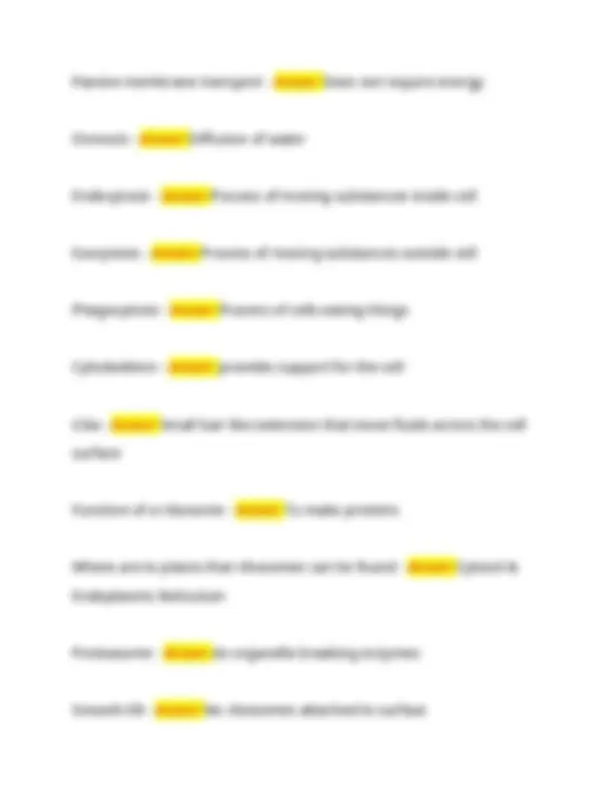
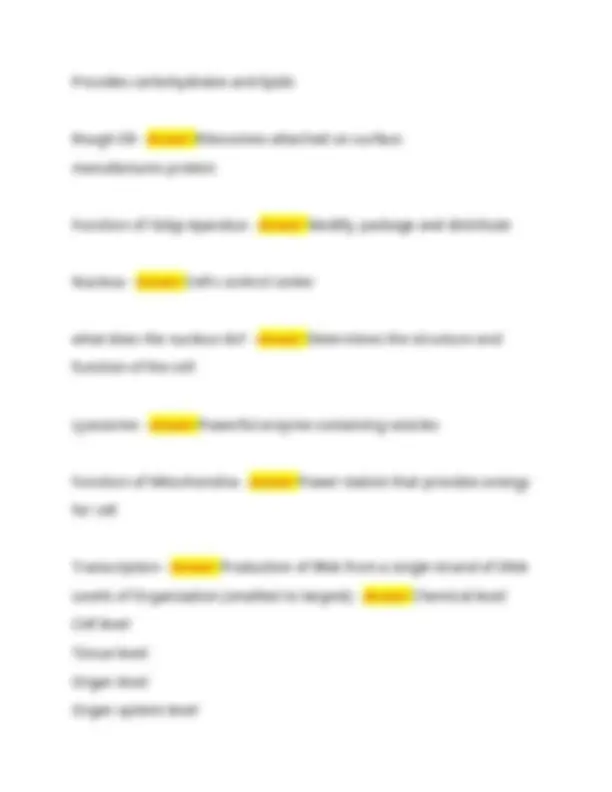
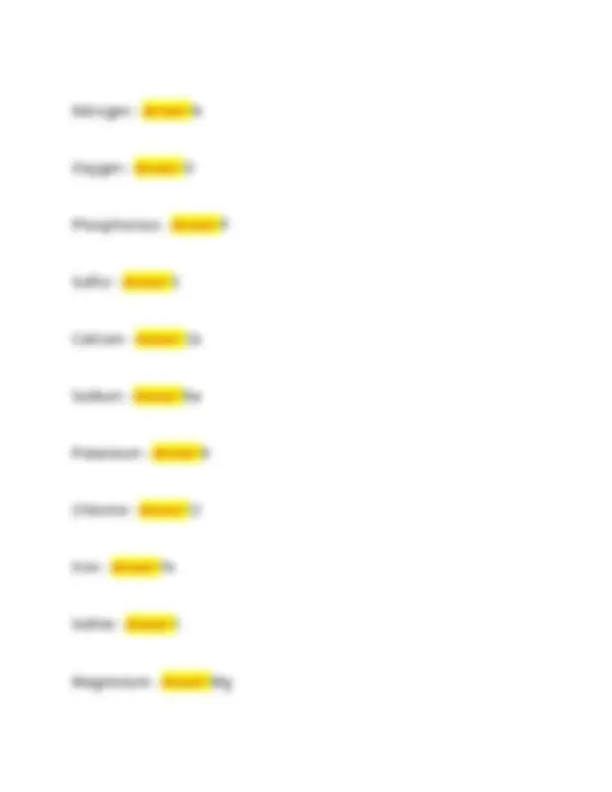
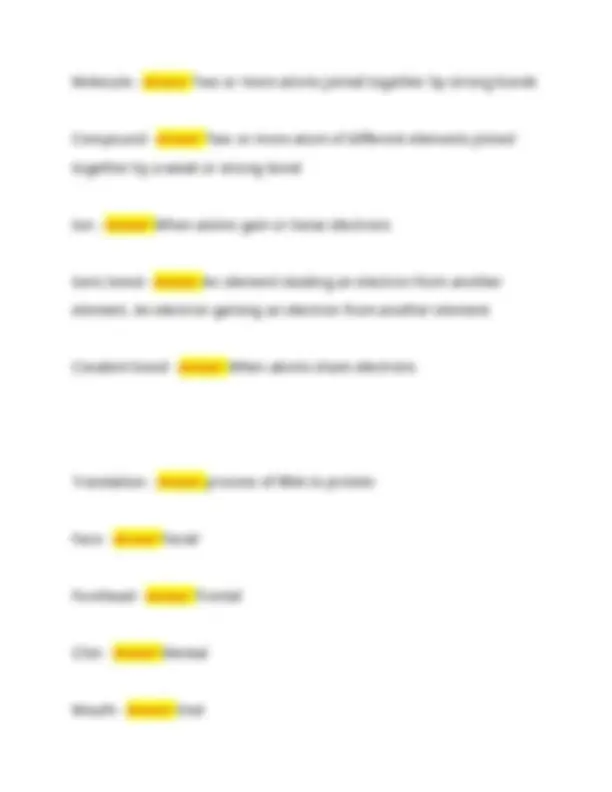
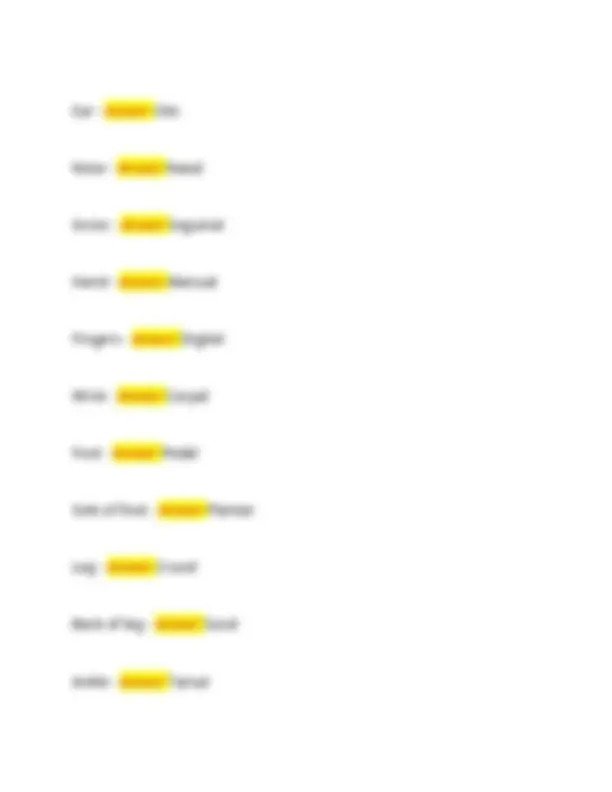


Study with the several resources on Docsity

Earn points by helping other students or get them with a premium plan


Prepare for your exams
Study with the several resources on Docsity

Earn points to download
Earn points by helping other students or get them with a premium plan
Community
Ask the community for help and clear up your study doubts
Discover the best universities in your country according to Docsity users
Free resources
Download our free guides on studying techniques, anxiety management strategies, and thesis advice from Docsity tutors
Anatomy & physiology (Chapters 1-3) exam review questions with correct solutions.
Typology: Exams
1 / 12

This page cannot be seen from the preview
Don't miss anything!







Anatomy - Answer Study of Structure Physiology - Answer Study of Function Bonds ranked in order of strength - Answer Covalent bonds Ionic bonds Hydrogen bonds Polar compound - Answer When a bond shares unequally Non polar compound - Answer bond sharing electrons equally Organic compound - Answer Molecules that contain carbon Inorganic compound - Answer Molecules that didn't contain carbon pH - Answer Measure of acid and base
Acid and base combines - Answer H2O Carbohydrate - Answer Simple sugars Lipid - Answer Fatty acids Hydrophobic - Answer Afraid of water Hydrophilic - Answer Water lover Components of a triglyceride - Answer three fatty acids attached Saturated fatty acid - Answer No carbon to carbon double bond Unsaturated - Answer Carbon to carbon double bond Basic building block of protein - Answer amino acids Primary, Secondary, Tertiary, and Quaternary structure of a protein - Answer Peptide bonding Two biologically important molecules formed by chained nucleic acids - Answer DNA & RNA
Passive membrane transport - Answer Does not require energy Osmosis - Answer Diffusion of water Endocytosis - Answer Process of moving substances inside cell Exocytosis - Answer Process of moving substances outside cell Phagocytosis - Answer Process of cells eating things Cytoskeleton - Answer provides support for the cell Cilia - Answer Small hair like extension that move fluids across the cell surface Function of a ribosome - Answer To make proteins Where are to places that ribosomes can be found - Answer Cytosol & Endoplasmic Reticulum Proteasome - Answer An organelle breaking enzymes Smooth ER - Answer No ribosomes attached to surface
Provides carbohydrates and lipids Rough ER - Answer Ribosomes attached on surface manufactures protein Function of Golgi Aparatus - Answer Modify, package and distribute Nucleus - Answer Cell's control center what does the nucleus do? - Answer Determines the structure and function of the cell Lysosome - Answer Powerful enzyme containing vesicles Function of Mitochondria - Answer Power station that provides energy for cell Transcription - Answer Production of RNA from a single strand of DNA Levels of Organization (smallest to largest) - Answer Chemical level Cell level Tissue level Organ level Organ system level
Dorsal, Ventral, Superficial, Proximal, Distal, Median, and Lateral in reference to Anatomy - Answer Directional References Saggital Plane - Answer View from right to left Transverse Plane - Answer View from Superior to Inferior Three subatomic particles - Answer Proton Neutron Electron What charges does a proton have - Answer Positive What charge does an electron have - Answer Negative What charges does a neutron have - Answer Positive and negative Which particle determines what element an atom will be - Answer The number of protons Carbon - Answer C Hydrogen - Answer H
Nitrogen - Answer N Oxygen - Answer O Phosphorous - Answer P Sulfur - Answer S Calcium - Answer Ca Sodium - Answer Na Potassium - Answer K Chlorine - Answer Cl Iron - Answer Fe Iodine - Answer I Magnesium - Answer Mg
Ear - Answer Otic Nose - Answer Nasal Groin - Answer Inguinal Hand - Answer Manual Fingers - Answer Digital Wrist - Answer Carpal Foot - Answer Pedal Sole of foot - Answer Plantar Leg - Answer Crural Back of leg - Answer Sural Ankle - Answer Tarsal
Palm - Answer Palmar Skull - Answer Cranial Eye - Answer Orbit / ocular Cheek - Answer Buccal Breast - Answer Mammary Armpit - Answer Axillary Arm - Answer Brachial Front of elbow - Answer Antecubital Thigh - Answer Femoral Kneecap - Answer Patella Shoulder - Answer Acromial Back - Answer Dorsal